I am going to again curate a scientific study, this time out of South Korea, that focuses on Aloe arborescens, a species of the Aloe plant, with its active ingredient Acemannan. Our focus is to address memory impairment, this time in groups of mice. Let’s begin . . .
The study is out of South Korea titled: Cognitive Enhancing Activity of Fermented Aloe arborescens Extract on Scopolamine-induced Memory Impairment in Mice. Aloe arborescens is slightly different than aloe vera (A. barbadensis). Acemannan is the active ingredient in both aloe plants but the most concentrated Acemannan is in the A. barbadensis. It has thicker leaves and more inner leaf gel, whereas because the Aloe arborescens has thinner leaves it has less inner leaf gel and the Acemannan is not as concentrated, though it is present.
Okay, with that botanical lesson out of the way let’s do the set up. These researchers tested how well mice could learn and remember, but they first created six groups of mice.
- The control group: These are healthy mice and were given no drugs and no aloe
- The Scopolamine group. These are mice that were injected with the drug scopolamine (a drug that causes memory loss)
- The AFE 100 group: These are mice were had been given scopolamine to cause memory loss but which had also been given 100 milligrams of Aloe Fermented Extract.
- The AFE 200 group. These are mice were had been given scopolamine to cause memory loss but which had also been given 200 milligrams of Aloe Fermented Extract.
- The AFE 300 group: These are mice were had been given scopolamine to cause memory loss but which had also been given 300 milligrams of Aloe Fermented Extract.
- The Donepezil group. Mice given a standard Alzheimer’s drug called Donepezil.
Why Fermentation in this study?
fermentation played a pivotal role in enhancing the extract’s efficacy. Fermentation, particularly with Lactobacillus brevis, was utilized to modify the chemical composition of Aloe arborescens, leading to increased bioavailability and potency of its active compounds. And, of course, as I mentioned earlier Acemannan is the active compound, the key bioactive component in the Aloe arborescens plant
In this first test scientists subjected mice to the Morris Water Maze, where mice must find a hidden platform in a pool of water. Mice with no memory problems got better each day, eventually finding the platform in about 12 seconds. But mice given scopolamine (a drug that causes memory loss) didn’t improve, still taking over 96 seconds by day 4.
When mice were treated with fermented Aloe arborescens extract, they improved significantly. At the high dose (200 mg/kg), they found the platform in about 12.2 seconds—almost like healthy mice. Lower doses helped too but were not as effective. The standard Alzheimer’s drug donepezil also helped, cutting the time to 33 seconds by day 4.
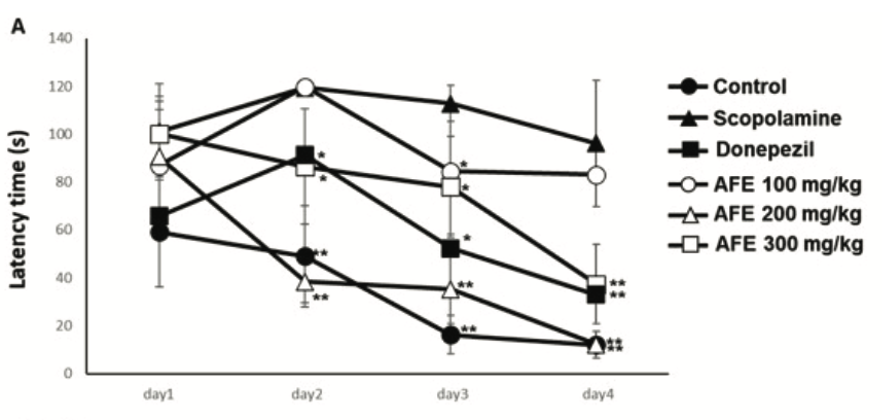
Swimming Distance Decreased with Aloe Treatment
The healthy mice swam the least distance indicated they had no trouble remembering where the platform was located in the pool. The scopolamine group swam much farther (2613 cm) than healthy mice (1503 cm), showing they had trouble remembering the location. Scopolamine/Aloe-treated mice swam shorter distances depending on the dose. This means they remembered where the platform was and didn’t waste time swimming aimlessly.
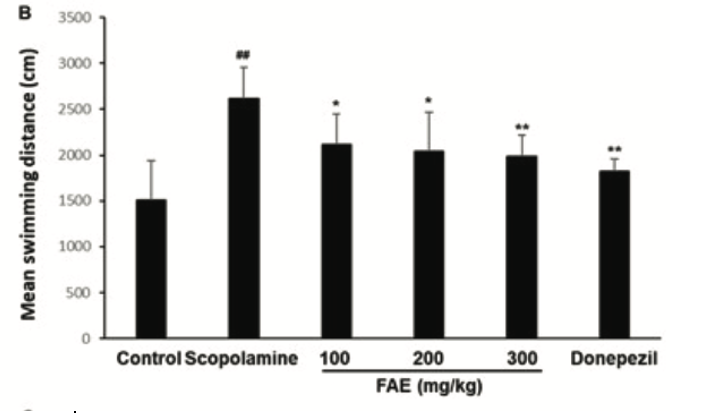
- Mice Spent More Time in the Right Area (Probe Test – Figure 1C) In the next test, the platform was removed to see if the mice remembered its location. Healthy mice spent 32.3 seconds in that area, basically thinking, its got to be here somewhere; whereas the Scopolamine mice only spent 8.3 seconds and than moved on. The Scopolamine/Aloe-treated mice spent more time there—up to 26.8 seconds—showing they did remember where the platform used to be.
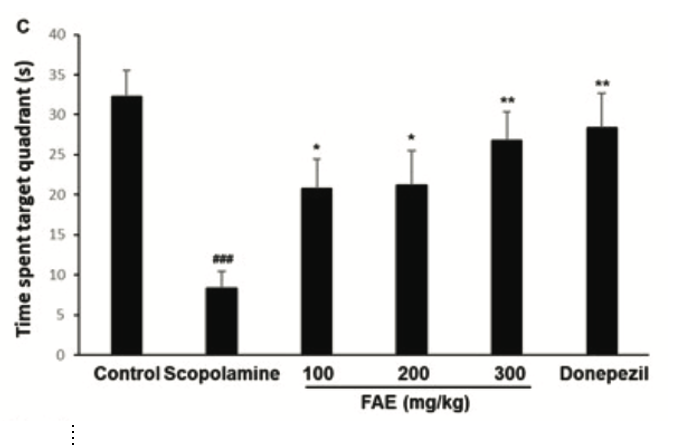
- Aloe Didn’t Just Make Mice Swim Faster (Figure 1D) Then the Scientists tested for swim speed. The wanted to know if the Aloe made mice swim faster. It didn’t. All groups swam at about the same speed. So, the faster finding times were due to better memory, not just quicker swimming.
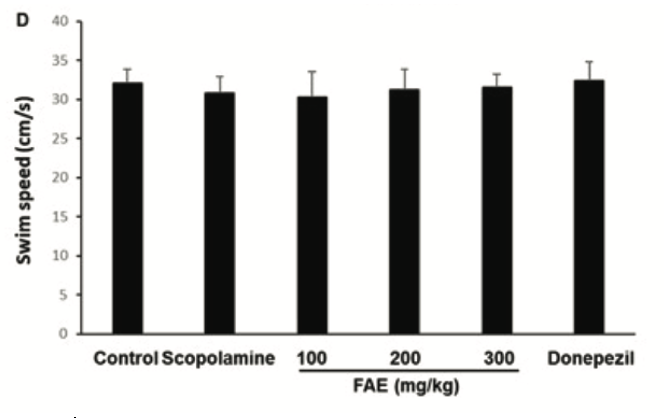
Now the study shifted to a different testing model. They discovered that Aloe helped long-term memory as well, using what is called a Passive Avoidance test. This same test was employed in a study that included lab rats we curated at this link:
In the passive avoidance test, the acquisition trial is the initial learning phase where the mouse is introduced to the test environment
A mouse is placed in a lighted chamber connected to a dark chamber.
Mice naturally prefer the dark, so they usually walk into it.
When they enter the dark side, they receive a mild foot shock.
This teaches the mouse to associate the dark chamber with discomfort.
This is the starting point for all the mice. Indicated by the white bars.
In the second test, all the mice are placed in the same environment. The healthy mice remembered the shock and waited about 11.4 seconds. Scopolamine mice forgot and entered quickly (about 4.2 seconds). The scopolamine/Aloe-treated mice waited longer again—especially the high-dose group, which waited over 10 seconds, almost like the healthy mice. This shows that Aloe helped recover long-term memory.
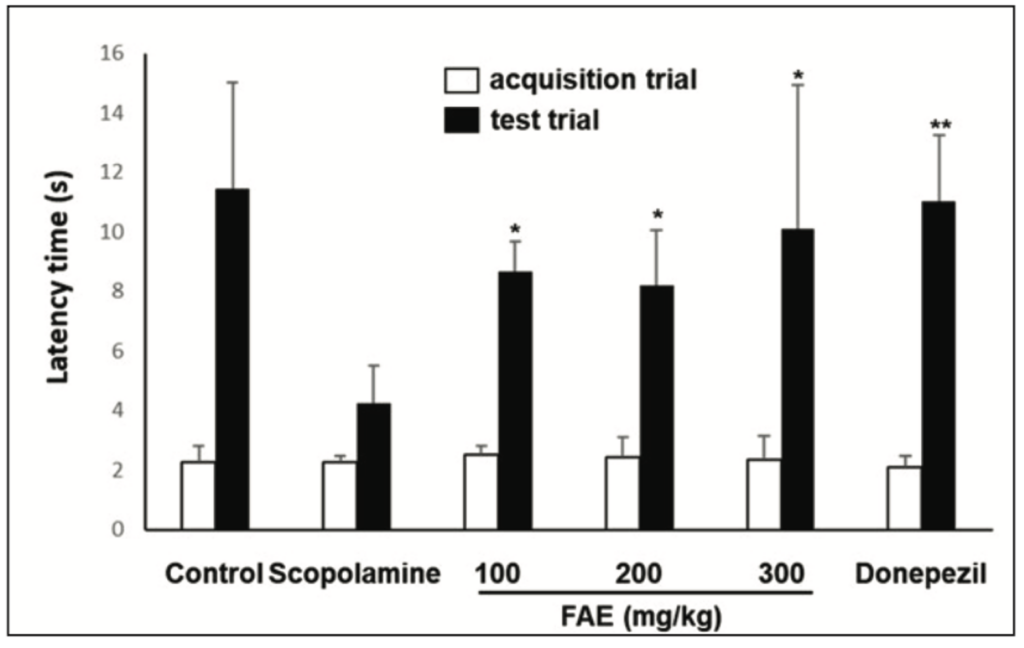
The next and final steps included evaluating the brain chemistry. Let’s break it down together—no lab coat needed. We’re about to take a closer look at what was happening inside the brain gleaned from microscopic discovery after the experiment was concluded and after treatment with Aloe extract. Yes, we’re going to meet a few unfamiliar terms—enzymes, proteins, and brain chemicals—but don’t worry. I’ll guide you through each one in simple terms so it all makes sense.”
The final steps in the study looked at brain chemistry—specifically, how the Aloe arborescens extract affected some important enzymes and proteins involved in memory and brain health.
First up: AChE, short for Acetylcholinesterase.
This is an enzyme that breaks down acetylcholine, acetylcholine is a crucial chemical your brain uses to send messages between brain cells. Too much AChE means too little acetylcholine, and that can seriously hurt memory. In the scopolamine group (the group that received a memory-blocking compound), AChE activity shot up by 142.2%. That’s not good.
Next, researchers looked at BDNF, which stands for Brain-Derived Neurotrophic Factor.
Think of BDNF as a kind of growth fertilizer for brain cells. It helps them grow, stay alive, and connect with one another—especially in the areas of the brain responsible for memory.
Then there’s p-CREB, (Phosphorylated cAMP Response Element-Binding Protein), yes, that classifies as another unfamiliar term, but it is a vital protein that works like a light switch for memory.
It helps “turn on” genes like BDNF. Together, BDNF and p-CREB are essential for learning and long-term memory. In the scopolamine group, both were lower than normal—another sign of poor brain function.
But here’s the good news:
In the group that received Aloe arborescens extract after being given scopolamine, the changes were noteworthy—and dose-dependent (meaning the more extract they received, the better the results), in other words the mice who had been given larger amounts of aloe extract had better results than the mice who had lesser amounts. We’ve talked about this dose dependence thing before. It is a prevalent theme with our multiple studies on Acemannan.
✅ AChE decreased – which means more acetylcholine stayed active, helping brain cells communicate better.
✅ BDNF increased – helping brain cells grow and thrive.
✅ p-CREB levels also rose – flipping on the “memory gene switch.”
All of this points to the growing body of knowledge that is curated here at this website
The fermented Aloe arborescens extract didn’t just help these mice recover from memory-blocking damage as a result of the Scopolamine—it helped restore the very building blocks of memory and cognitive health in mice.
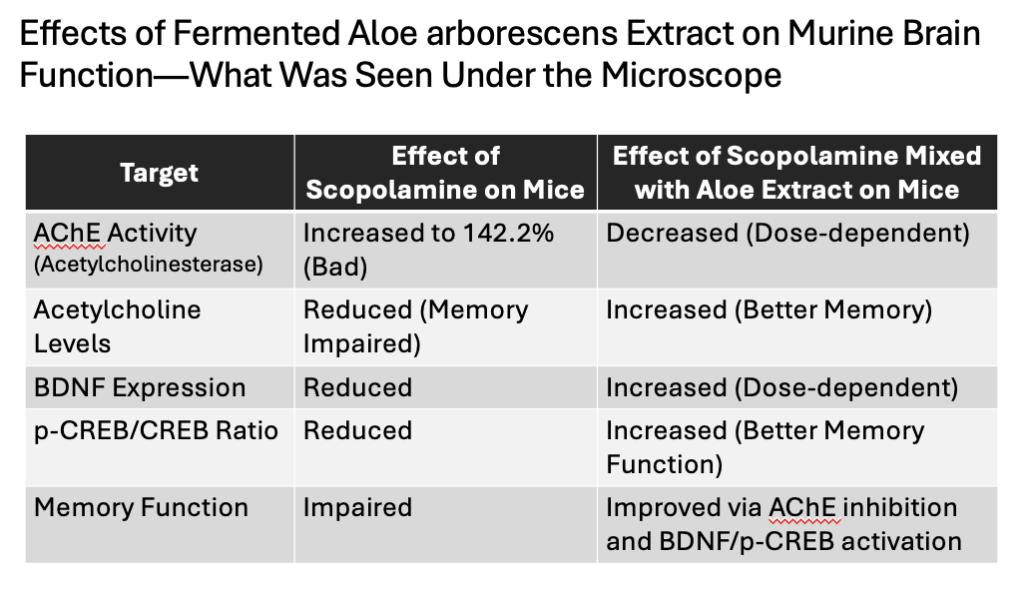
Summary:
Fermented Aloe arborescens extract helped reverse drug-induced memory loss by:
- Protecting key brain chemicals
- Boosting memory-related proteins
- Improving communication between brain cells
Postscript
Although Donepezil (commonly known as Aricept) was included in the study as a comparison treatment, it was not discussed in much detail. This pharmaceutical drug is approved for Alzheimer’s and is known to produce side effects such as nausea, vomiting, diarrhea, muscle cramps, fatigue, and trouble sleeping. Less Common but Serious Side Effects that may require medical attention:
- Bradycardia (slow heart rate)
- Fainting
- Seizures
- Stomach ulcers or bleeding (especially if taken with NSAIDs like ibuprofen)
- Urinary incontinence
- Hallucinations or unusual dreams
- Breathing problems (especially in people with asthma or COPD)
In contrast, Acemannan—a natural, non-toxic polysaccharide found in Aloe species— is not approved for Alzheimers, is most often the key active component featured in all Aloe-related research we reveal at this website. This study followed that trend by focusing on Aloe’s cognitive effects, though in this case, it introduced something relatively new: a fermented extract of Aloe arborescens. To my understanding, this fermented version is not currently available as a commercial product and “We have every reason to believe that Acemannan is present in the mixture, simply because the experiment utilized the Aloe plant, of which Acemannan is a naturally occurring component.” Plus, as is pointed out in the study fermentation was employed to increase bioavailability and potency of its active compounds, which would include Acemannan.
I hope you will always be careful to maintain good works to meet urgent needs and become heroes to your generation.
Final Conclusion: Fermented Aloe arborescens extract helped mice recover from memory problems caused by scopolamine. It worked by boosting important brain proteins like BDNF that help brain cells grow and form memories. This suggests it could one day help prevent or treat memory loss diseases like Alzheimer’s—though more research is needed.
0 Comments